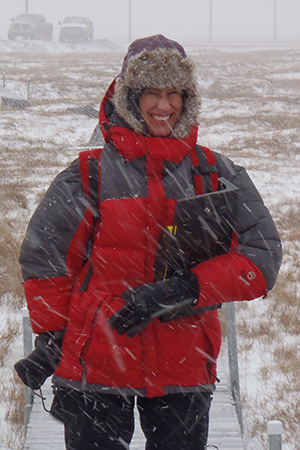The underground: Studying the Arctic tundra
Normally, scientists don’t have to worry about a polar bear charging them at 30 miles per hour. But when you do fieldwork in Barrow, Alaska, polar bears are a big safety concern.
“It’s all white—at times it’s even hard to see the horizon—and the polar bears are white,” says geophysicist Susan Hubbard (Ph.D.’98 CEE). “When you’re working, you’re looking at the ground and the sensor, so it’s hard to always look up. And the polar bears are fast and aggressive—they actually hunt you. We’ve hired bear guards to come out with us to the field.”
Hubbard is the director of the Earth Sciences Division at Lawrence Berkeley National Laboratory and part of the Next-Generation Ecosystem Experiment (NGEE-Arctic), a large collaboration of scientists and engineers who are trying to better understand the Arctic ecosystem so they can improve climate modeling.
At a research site near Barrow, Hubbard’s research team is studying the structure beneath the Arctic’s ground surface. The uppermost ground layer—called the active layer—thaws in the summer and freezes in the winter. Below that is a permanently frozen layer, called permafrost.
The Arctic is critical to understanding the global climate. About half the carbon stored in the Earth’s soil is in the Arctic, where organic matter is locked in place by permanently frozen subsoil. As those regions thaw, the worry is that tiny microbes will start feeding on the long-stored organic material and start releasing large quantities of greenhouse gases.
“Our goal is to understand the structure beneath the subsurface,” says Hubbard. “How thick is the active layer? How thick is the permafrost? What are the variations in moisture content and geochemistry, and how do those variations influence greenhouse gas generation?”

Hubbard’s team is using geophysical tools—seismic, radar and electrical—to determine what’s beneath the ground. They also collect core samples that are analyzed back in Berkeley.
In seismic tests, researchers hit the tundra with a sledgehammer to send an acoustic pulse into the ground. The velocity of the pulse is sensitive to physical structure and reveals whether or not the deeper permafrost layers are frozen.
Last year, these seismic tests led to surprising results. Scientists thought the permafrost started about a half-meter below the ground surface and continued for hundreds of meters. But Hubbard’s team discovered unfrozen saline zones, starting about two meters below the top of the permafrost and running many meters deep.
“We chose the Barrow site because it is cold and had continuously frozen permafrost,” says Hubbard, laughing. “And we find out that the northernmost city in North America, with supposedly the most continuous permafrost area, is not really continuous. It could have big implications. There could be microbes right now that are active in this buried, unfrozen zone, with wintertime or even yearlong greenhouse respiration. We will be returning to the site this May to drill deep holes, collect gas samples and test this hypothesis.”
Hubbard’s team is also measuring the subsurface with ground penetrating radar, which sends electromagnetic waves into the ground that bounce off the interface between sublayers. The measurements are taken by pulling radar-equipped sleds across the Arctic tundra, either on foot or behind a snowmobile.
“We’ve found radar to be extremely helpful for mapping the active layer,” says Hubbard. “We’ve been going up there every freeze, winter, thaw and growing season for a few years and measuring the active layer dynamics—basically, the thaw depth.”
They also measure the moisture content, based on the subsurface’s ability to conduct electrical current. This electrical data is taken either by planting electrodes in the ground or pulling an electromagnetic sensor across the tundra.
All of these subsurface measurements of the Barrow Peninsula are critical to understanding how the Arctic is changing. But NGEE-Arctic also seeks to understand the relationship between the changes below ground to the land above.
“We’ve been taking kites mounted with sensors to image the land surface at the same time that we’re imaging the subsurface,” says Hubbard. In the past, they’ve also used landscape data mapped from a twin engine Cessna plane.
The goal is to transfer the knowledge of their detailed subsurface measurements to the scale used in standard climate models. Hubbard’s team measures subsurface features in centimeters, but the smallest element in a climate model is 30×30 kilometers—a million times larger.
“There is a tight coupling of the land surface and the below-ground expression,” says Hubbard. “We would like to be able to infer a lot about the subsurface from measuring the micro-topography. That would really help us to parameterize this big climate model, because it is easy to acquire topographic measurements.”
NGEE-Arctic is an ambitious, 10-year study that’s funded by the Department of Energy. Despite the harsh conditions of the fieldwork, scientists are very excited about the project.
“We work really hard all day long out in the cold weather. Sometimes it’s as low as minus 20 degrees Fahrenheit,” says Hubbard. “We work really late and eat dinner really late. Then we come back to our little pink Quonset hut and crank on data for several more hours. The data have been gorgeous. There is so much good energy and so many exciting scientific challenges. So it’s very, very fun.”









